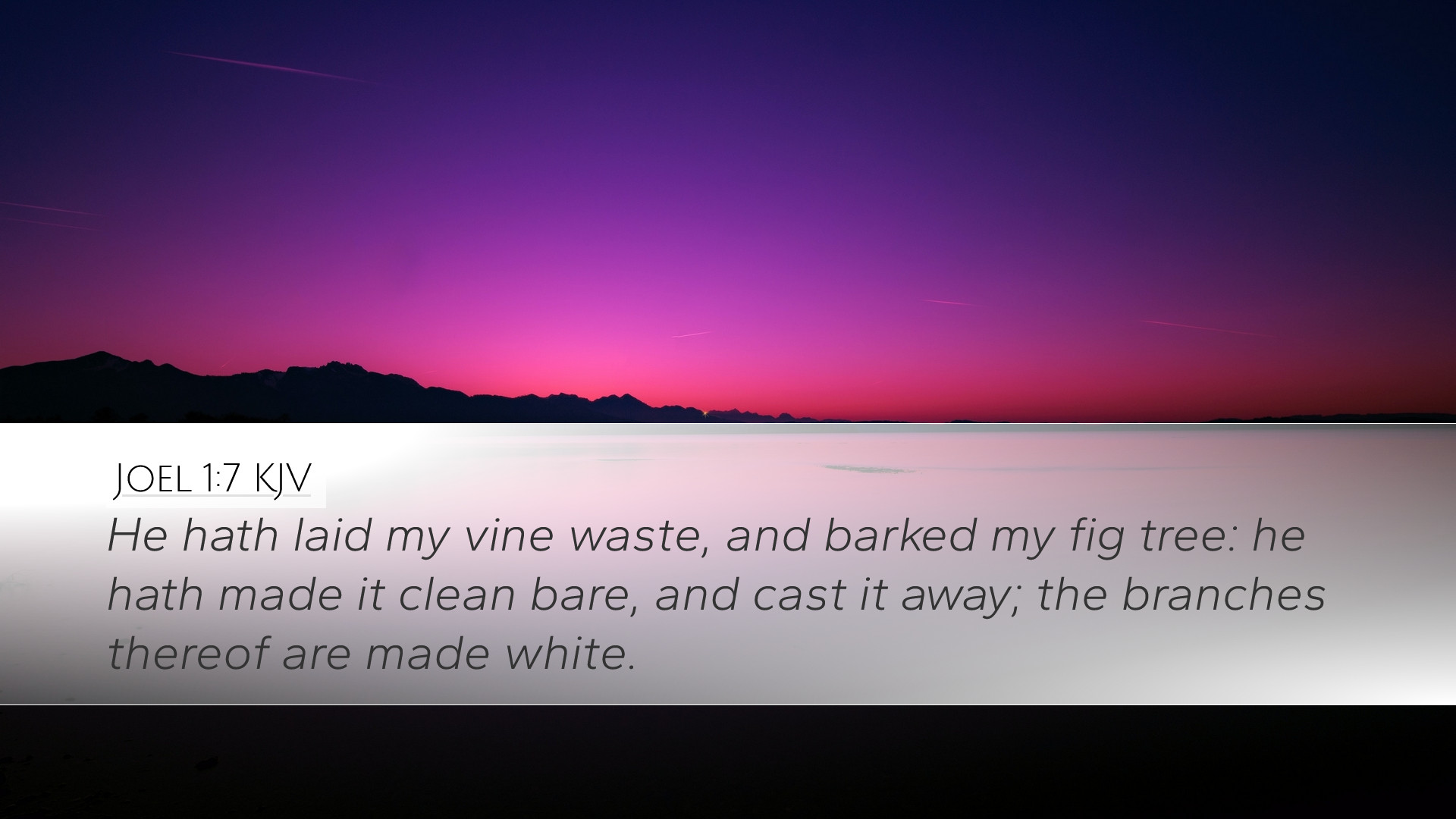Old Testament
Genesis Exodus Leviticus Numbers Deuteronomy Joshua Judges Ruth 1 Samuel 2 Samuel 1 Kings 2 Kings 1 Chronicles 2 Chronicles Ezra Nehemiah Esther Job Psalms Proverbs Ecclesiastes Song of Solomon Isaiah Jeremiah Lamentations Ezekiel Daniel Hosea Joel Amos Obadiah Jonah Micah Nahum Habakkuk Zephaniah Haggai Zechariah MalachiJoel 1:7
Joel 1:7 KJV
He hath laid my vine waste, and barked my fig tree: he hath made it clean bare, and cast it away; the branches thereof are made white.
Joel 1:7 Bible Commentary
Commentary on Joel 1:7
Text: "He hath laid my vine waste, and barked my fig tree: he hath made it clean bare, and cast it away; the branches thereof are made white."
Introduction
The prophecy of Joel serves as a solemn reminder of God’s judgment and the call to repentance. In Joel 1:7, we see a vivid image that illustrates the desolation brought upon the land due to divine instruction. This commentary draws upon the insights from public domain sources, particularly emphasizing the implications for contemporary life.
Historical Context
This verse occurs within a context of national calamity following a plague of locusts, which symbolizes divine punishment. The imagery of the vine and fig tree, which are critical to Israel's agricultural economy and cultural identity, suggests not only physical destruction but also a profound spiritual barrenness.
Commentary Insights
Matthew Henry:
Henry emphasizes the metaphorical significance of the vine and fig tree as representative of God's people. The devastation reflects a loss of fellowship and blessing. He interprets this destruction as a result of sin, suggesting that divine judgment is not arbitrary but a response to human actions. The “clean bare” state is indicative of a remnant left, a precursor to God's future restoration.
Albert Barnes:
Barnes elaborates on the literal and spiritual ramifications of the verse. He portrays the locusts as a divine army sent for judgment, ravaging the land—the vine and fig being emblematic of prosperity and hope. His interpretation focuses on the theme of repentance; the rhetorical question posed by God calls the people to acknowledge their transgressions, prompting a return to spiritual fidelity.
Adam Clarke:
Clarke provides a robust linguistic analysis of the terms used in the verse. He highlights that “barked” signifies complete destruction down to the bark layer, indicating total desolation. Clarke's examination attaches eschatological significance to the state of the trees, symbolizing the necessity for spiritual renewal in a time of scarcity. He urges readers to understand the severity of alienation from God, as it leads to visible decline in community wellbeing.
Theological Implications
This verse compels believers to consider their relationship with God, emphasizing that spiritual health directly affects bodily and communal well-being. The devastation serves as an allegory for the ramifications of sin and neglect. The themes extracted from the commentaries can inform a theological discourse on the nature of God's judgment and grace.
Key Themes
- Divine Judgment: The destruction of the vine and fig tree highlights God’s sovereignty in administering justice. This raises questions about the nature and purpose of God’s corrective measures.
- Call to Repentance: Joel’s lament is a rallying call for introspection and communal penance. The imagery points toward the necessity for restoration through reconciliation with God.
- Hope of Restoration: Despite the somber tone, the promise of restoration resonates throughout the book of Joel. Scholars agree that acknowledging brokenness can lead to renewal and revitalized blessings from God.
Practical Applications
For pastors and leaders in the church, Joel 1:7 emphasizes the need for discernment regarding the spiritual condition of their communities. Recognizing the signs of ‘lack’ should prompt a proactive approach to guide congregations toward repentance and healing.
Guiding Questions
- What are the contemporary “locusts” that ravage our spiritual and communal integrity?
- How can the church facilitate a culture of repentance and restoration?
- In what ways can we cultivate spiritual health that manifests in tangible community blessings?
Conclusion
Joel 1:7 serves as a poignant reminder of the consequences of sin and the need for a return to a sincere relationship with God. By understanding the extensive biblical and theological implications of this verse, believers can strive toward spiritual restoration that brings blessings, not only for themselves but for their entire community.


